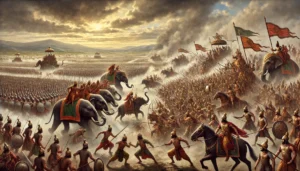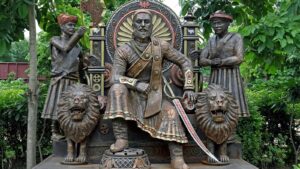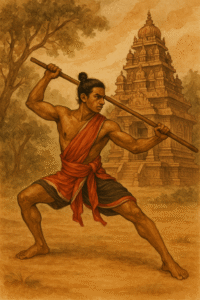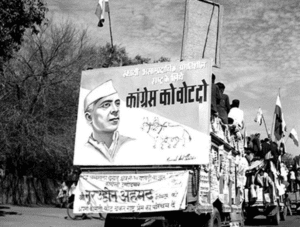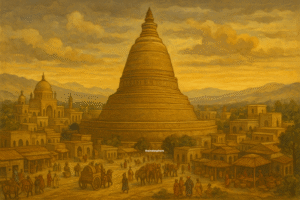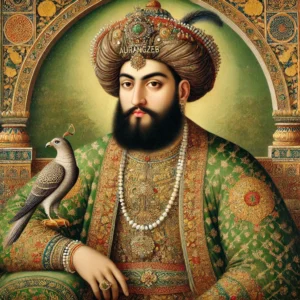India’s rich history is full of powerful dynasties that have shaped its cultural, political, and economic landscape. Among these dynasties, the Western Satraps, also known as Sakas, ruled parts of western and central India from the 1st to 4th century CE. Despite their importance, they are often overlooked in discussions of Indian history. In this article, we will dive deep into the untold story of the Western Satraps: their origins, key rulers, wars, governance, economy, and eventual decline.
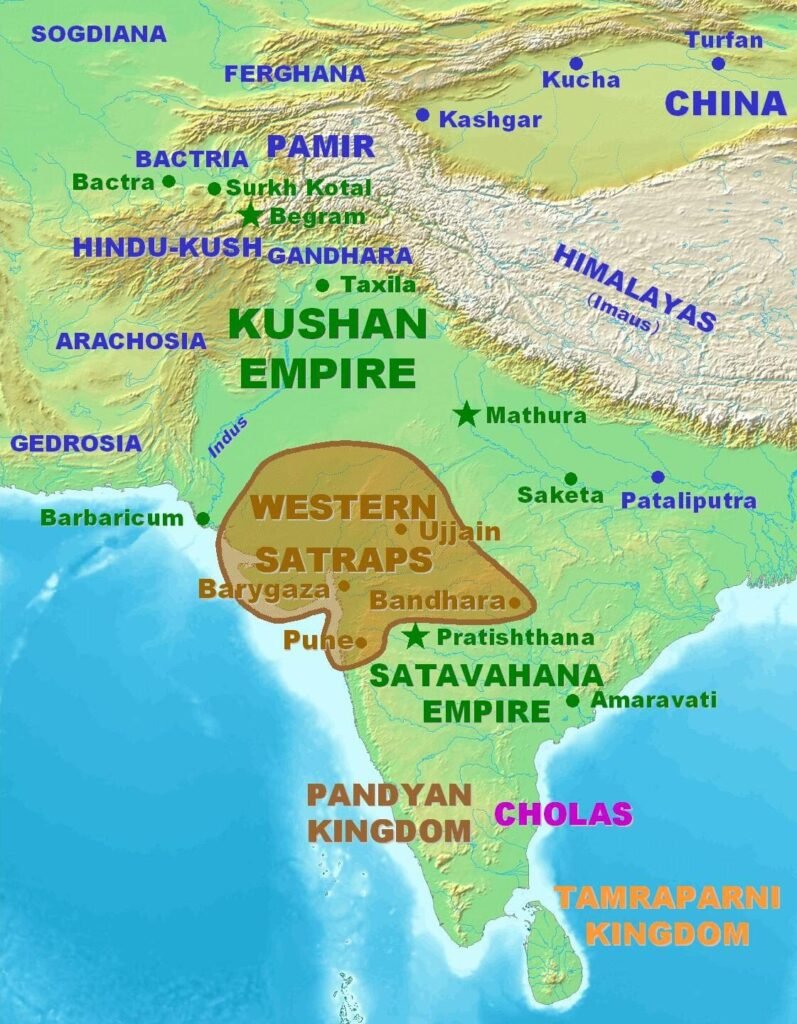
Who Were the Western Satraps?
The Western Satraps were part of a broader migration of nomadic tribes from Central Asia into India. They were originally Scythians, a people who lived on the Central Asian steppes, known for their horse-riding skills and military prowess. As these tribes were pushed westward by other nomads, they began to settle in regions such as Bactria and Sogdia, and eventually made their way into India, where they established themselves as rulers.
Their entry into India coincided with the fall of the Indo-Greek Kingdoms and the weakening of local dynasties. The Sakas were able to fill this power vacuum and quickly seized control of parts of western India, including Gujarat, Madhya Pradesh, and Maharashtra. These areas were highly significant for trade, with ports along the western coast allowing access to the vast networks connecting India with Rome, the Middle East, and East Africa.
The Western Satraps first came to prominence under the leadership of Chashtana, who ruled around 78 CE. Chashtana established his kingdom in Ujjain, a major center of commerce and culture in central India. Ujjain was strategically important as it controlled routes that connected northern India with the southern kingdoms, making it a vital hub for both trade and military movements.
In adopting the title “Kshatrapa” (Satrap), they borrowed a term from the ancient Persian Achaemenid Empire, where satraps were provincial governors. However, the Western Satraps weren’t mere governors; they ruled independently over a large territory.
Major Rulers and Achievements
The Western Satraps produced several influential rulers who expanded their territory, strengthened trade networks, and contributed to the cultural landscape of ancient India. Two of the most important rulers were Nahapana and Rudradaman I, whose reigns were characterized by military expansion, economic development, and cultural achievements.
Nahapana (119–124 CE)
Nahapana was one of the most powerful early rulers of the Western Satraps. During his reign, the Satraps expanded their territory significantly and gained control of key regions, particularly along the western coast. This allowed them to control important ports and enhance maritime trade with foreign markets, particularly with the Roman Empire.
Evidence of Nahapana’s power comes from the large number of coins minted during his reign. These coins, featuring his portrait on one side and symbols of Indian deities on the other, indicate a well-organized economy and a stable administration. The inscriptions on the coins were often in Greek and Prakrit, reflecting the multi-cultural influences in his kingdom.
However, Nahapana’s reign came to an abrupt end when he was defeated by Gautamiputra Satakarni, the king of the Satavahana dynasty, in one of the most decisive battles of the time. This defeat was a temporary setback for the Satraps, but their power was soon restored under a new ruler.
Rudradaman I (130–150 CE)
The most celebrated ruler of the Western Satraps was Rudradaman I, whose reign was marked by military success, effective governance, and cultural patronage. Rudradaman is best known for his victory over the Satavahanas, reversing the loss suffered by Nahapana and restoring the Western Satraps’ dominance in the region. He was a brilliant military commander who expanded the Satraps’ territory into parts of Gujarat, Madhya Pradesh, and Saurashtra.
Rudradaman’s reign was not just about military expansion. He was also known for his administrative skills and commitment to public welfare. One of his most famous achievements was the repair of the Sudarsana Lake near Junagarh, which had been damaged by floods. His efforts to restore this irrigation system helped improve agricultural productivity, demonstrating his concern for the welfare of his subjects.
Rudradaman’s legacy is also evident in the Junagarh rock inscription, one of the earliest surviving inscriptions in Sanskrit. This inscription provides detailed accounts of his military conquests and public works, offering valuable insights into the cultural and political climate of his time. Rudradaman was also a patron of the arts and literature, and his reign marked a period of cultural flowering in the region.
How Did the Western Satraps Govern?
The term “Satrap” refers to a governor in ancient Persian administration. The Western Satraps ruled a series of semi-autonomous regions under a central authority, similar to the Persian model. While they controlled a large area, local rulers under their command were allowed to manage their territories. This created a feudal system of governance where local chiefs enjoyed some independence but remained loyal to the central authority.
This administrative system allowed the Western Satraps to maintain control over a vast region while keeping local governance relatively stable. The decentralized model also helped manage the complex ethnic and cultural diversity within their empire, which spanned large parts of western and central India.
Economic Achievements: Trade and Coinage
One of the greatest achievements of the Western Satraps was their contribution to trade. Their kingdom was strategically located along key trade routes, including coastal cities like Bharuch, which were essential for maritime trade between India and foreign markets, particularly the Roman Empire. This access to international trade routes fostered economic growth and wealth accumulation in the region.
The Western Satraps were intermediaries in the trade of valuable goods such as spices, textiles, precious gems, and ivory. Their role as traders connecting India with the Middle East and the Mediterranean helped integrate western India into global trade networks, enriching their economy.
They also issued a large volume of coins, which provide valuable insights into their governance, economy, and religious influences. These coins typically depicted portraits of their rulers on one side and various symbols or deities on the other. The inscriptions on the coins were in multiple languages, including Greek, Prakrit, and later Brahmi, reflecting the cultural diversity within their kingdom. The widespread use of their coinage helped facilitate trade and commerce, not just within their empire but across regions.

Religious and Cultural Contributions
The Western Satraps were originally from Central Asia and practiced Zoroastrianism, the ancient religion of Persia. However, after settling in India, they began to adopt Indian religions, such as Hinduism, Buddhism, and Jainism. This religious adaptation is a clear example of how the Satraps integrated into Indian society, blending their foreign origins with local traditions.
The reign of Rudradaman I stands out for its cultural contributions, particularly to Sanskrit literature. The Junagarh inscription, commissioned by Rudradaman, is not only a landmark in Indian epigraphy for its linguistic significance but also provides a detailed account of the ruler’s achievements in governance, military success, and public infrastructure projects.

This period also saw the development of art, architecture, and literature, blending Indian and Central Asian styles, which contributed to the region’s rich cultural heritage.
Wars and Conflicts
The Western Satraps were frequently involved in wars and conflicts, both with local Indian kingdoms and with foreign invaders. The most notable conflicts were with the Satavahanas, rulers of the Deccan Plateau.
The rivalry between the Satraps and the Satavahanas was one of the most important struggles of this period. The two powers fought several wars over control of strategic regions in western and central India, especially areas rich in trade routes.
The first major conflict occurred during the reign of Nahapana, who was defeated by Gautamiputra Satakarni around 124 CE. This victory allowed the Satavahanas to reclaim lost territories, but the Western Satraps soon regained control under Rudradaman I, who crushed the Satavahanas and restored Satrap dominance.
The ongoing conflicts between these two powerful dynasties shaped the political landscape of ancient India and influenced the dynamics of trade and cultural exchange between northern and southern India.
Decline and Fall of the Western Satraps
The Western Satraps continued to rule into the 4th century CE, but their power steadily declined due to a combination of internal strife, external pressures, and the rise of powerful new empires. Internal power struggles weakened the central authority, while the emergence of external powers, most notably the Gupta Empire, hastened their fall.
The decisive blow came during the reign of Chandragupta II
(Vikramaditya) of the Gupta dynasty. In the 390s CE, Chandragupta II defeated the last Satrap rulers and absorbed their territories into the Gupta Empire. This victory marked the end of the Western Satraps as a political force and ushered in a new era dominated by the Guptas, whose empire became one of the most influential in Indian history.
The Legacy of the Western Satraps
Despite their eventual fall, the Western Satraps left a lasting legacy in the regions they once ruled. Their control of important trade routes helped integrate western India into global economic networks, and their coins remain a rich source of historical information today, revealing insights into the politics, economy, and religious practices of their time.
Culturally, they played a significant role in preserving and promoting Indian traditions while incorporating elements from their Scythian heritage, resulting in a unique blend of Indian and Central Asian culture. Their contributions to infrastructure, governance, and trade set the stage for later dynasties, including the Guptas, to build upon and further develop these regions.
Conclusion
The story of the Western Satraps is a fascinating chapter in India’s ancient history, marked by military conquests, economic prosperity, and cultural integration. Though their reign might not be as widely recognized as that of the Mauryas or Guptas, their influence on trade, religion, and governance in western India is undeniable. By bridging the gap between nomadic Central Asian traditions and the established cultures of the Indian subcontinent, the Western Satraps left an indelible mark on India’s historical and cultural landscape.
This ancient dynasty deserves more attention, as their rich legacy continues to be felt in the archaeological finds, inscriptions, and historical records they left behind. The Western Satraps were not just foreign invaders—they were key contributors to India’s development in the early centuries of the Common Era.

